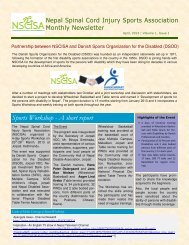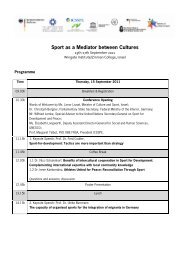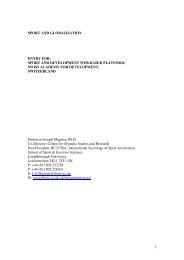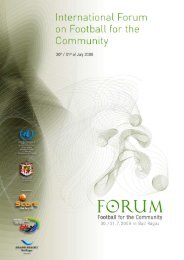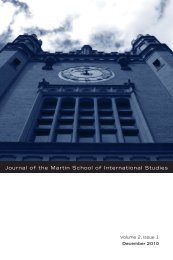The contribution of sport within the process - International Platform ...
The contribution of sport within the process - International Platform ...
The contribution of sport within the process - International Platform ...
You also want an ePaper? Increase the reach of your titles
YUMPU automatically turns print PDFs into web optimized ePapers that Google loves.
2.7.2 SPORT IN REBUILDING RELATIONSHIPS<br />
Truth and justice are central to reconciliation, which is primarily aimed at<br />
(re)building positive relationships between former enemies, both <strong>of</strong> whom may have<br />
committed atrocities against <strong>the</strong> o<strong>the</strong>r, and both <strong>of</strong> who may see <strong>the</strong>mselves as <strong>the</strong><br />
victim 17 (Kriesberg, 2003).<br />
Sport and game activities can create <strong>the</strong> necessary space through confidence and<br />
trust to discuss after several months about problems in <strong>the</strong> family or school emerging<br />
from <strong>the</strong> war. Building trust requires that each party — victim and <strong>of</strong>fender — gains<br />
renewed confidence in himself or herself and in each o<strong>the</strong>r. Building trust also entails<br />
seeing <strong>the</strong> humanity in every individual. This acknowledgement is <strong>the</strong> basis for <strong>the</strong><br />
mutual trust required to build a lasting culture <strong>of</strong> peace.<br />
Lederach (2005) has <strong>the</strong>orized a ‘web approach’ to peace-building. He<br />
encourages interventions that explicitly focus on strategic networking or ‘web-making,’<br />
a term used to describe <strong>the</strong> building <strong>of</strong> relationships. Web-making is especially<br />
relevant for NGOs working in <strong>the</strong> field <strong>of</strong> <strong>sport</strong>s and reconciliation. As <strong>the</strong>y are middle-<br />
level actors, <strong>the</strong>y are ideally located to bring people toge<strong>the</strong>r and weave dialogue,<br />
ideas and programs across boundaries. By capitalizing on key social spaces, <strong>the</strong>y are<br />
able to spin a web <strong>of</strong> sustainable relationships: “…<strong>The</strong> goal is to create a web that has<br />
a capacity to receive blows and even structural damage to one part without those<br />
points <strong>of</strong> damage destroying <strong>the</strong> rest <strong>of</strong> <strong>the</strong> web. <strong>The</strong> structure <strong>of</strong> <strong>the</strong> web combines<br />
interdependent connections with localized independence. Strength is built by creating<br />
coordination at <strong>the</strong> hub without centralization” (Lederach, 2005, p.83). 18<br />
2.7.3 SPORT IN BUILDING EMPATHY<br />
Building empathy is an essential stage in <strong>the</strong> reconciliation <strong>process</strong>. Empathy<br />
comes with <strong>the</strong> willingness <strong>of</strong> victims to listen to <strong>of</strong>fenders’ reasons for causing <strong>the</strong>m<br />
pain, and with <strong>of</strong>fenders’ listening to and understanding <strong>the</strong> anger and bitterness <strong>of</strong><br />
those <strong>the</strong>y have hurt. Truth-telling is one way to make this possible, creating<br />
17 Kriesberg, Louis (2003) “Constructive Conflicts, From Escalation to Resolution”. 2nd ed.<br />
Rowman and Littlefield. Oxford.<br />
18 Sport for Development and Peace <strong>International</strong> Working Group. “Literature Reviews on<br />
Sport for Development and Peace (Toronto: SDP IWG Secretariat, 2007)<br />
Borsani Serena – Master in Human Rights and Conflict Management 2008<br />
Dissertation<br />
25<br />
“objective opportunities for people to see <strong>the</strong> past in terms <strong>of</strong> shared suffering and<br />
collective responsibility.” It also helps victims and <strong>of</strong>fenders to recognize <strong>the</strong>ir shared<br />
humanity and <strong>the</strong> reality that <strong>the</strong>y all have to move forward by getting along with each<br />
o<strong>the</strong>r. Sport can be used to build empathy and as an information platform to inform<br />
people <strong>of</strong>, and promote, truth telling <strong>process</strong>es (SDP IWG) 19<br />
Sport can be also used as an important pedagogical forum for peace-building and<br />
reconciliation engage in talks or educational programmes regarding <strong>the</strong> benefits <strong>of</strong><br />
social integration, reconciliation and peaceful co-existence.<br />
2.8 SPORT AS MECHANISM FOR A SOCIAL CHANGE<br />
Combining as said above is possible to come out with a nested graph. <strong>The</strong> work <strong>of</strong><br />
peace researcher and <strong>the</strong>orist Marie Dugan provides ano<strong>the</strong>r helpful framework to<br />
understand <strong>the</strong> potential interventions <strong>of</strong> <strong>sport</strong>. Her ‘nested paradigm’ links <strong>the</strong> narrow<br />
challenges <strong>of</strong> conflict resolution to <strong>the</strong> broader necessity <strong>of</strong> peace-building.<br />
Dugan suggests that addressing <strong>the</strong> problem at <strong>the</strong> sub-system level (<strong>the</strong><br />
immediate system that <strong>the</strong> parties are located in, i.e. a school or work place) provides<br />
<strong>the</strong> best point to make positive change in <strong>the</strong> whole. <strong>The</strong> sub-system allows a<br />
framework for manipulating relationships, solving issues and contributing to wider<br />
systemic changes. Issues arise <strong>within</strong> relationships, which exist <strong>within</strong> <strong>the</strong> larger<br />
context <strong>of</strong> subsystems, and ultimately society-wide systems.<br />
In this context <strong>the</strong> Who, <strong>the</strong> What and <strong>the</strong> How summarized in <strong>the</strong> graph can give a<br />
support in understanding <strong>the</strong> necessary dynamic to make a <strong>sport</strong> for reconciliation<br />
project a success.<br />
Timing too is important but in this dissertation peace-building is seen as a<br />
endless <strong>process</strong> where as soon as reconciliation is considered to be achieved,<br />
activities do not end up in order to maintain <strong>the</strong> new social integration and prevent<br />
fur<strong>the</strong>r conflicts.<br />
<strong>The</strong> Where, not shown in <strong>the</strong> graph, is strictly linked to <strong>the</strong> How. At grassroots<br />
level a social space <strong>within</strong> an identified location will be <strong>the</strong> field to implement <strong>the</strong><br />
project. Elite athletes, <strong>sport</strong> ambassadors, international and local NGO’s will play an<br />
19 Sport for Development and Peace <strong>International</strong> Working Group. “Sport for Development<br />
and Peace: Governments in Action” (Toronto: SDP IWG Secretariat, 2008)<br />
Borsani Serena – Master in Human Rights and Conflict Management 2008<br />
Dissertation<br />
26



